RENAULT MEGANE SPORT TOURER 2016 X95 / 3.G Owners Manual
Manufacturer: RENAULT, Model Year: 2016, Model line: MEGANE SPORT TOURER, Model: RENAULT MEGANE SPORT TOURER 2016 X95 / 3.GPages: 268, PDF Size: 5.01 MB
Page 131 of 268
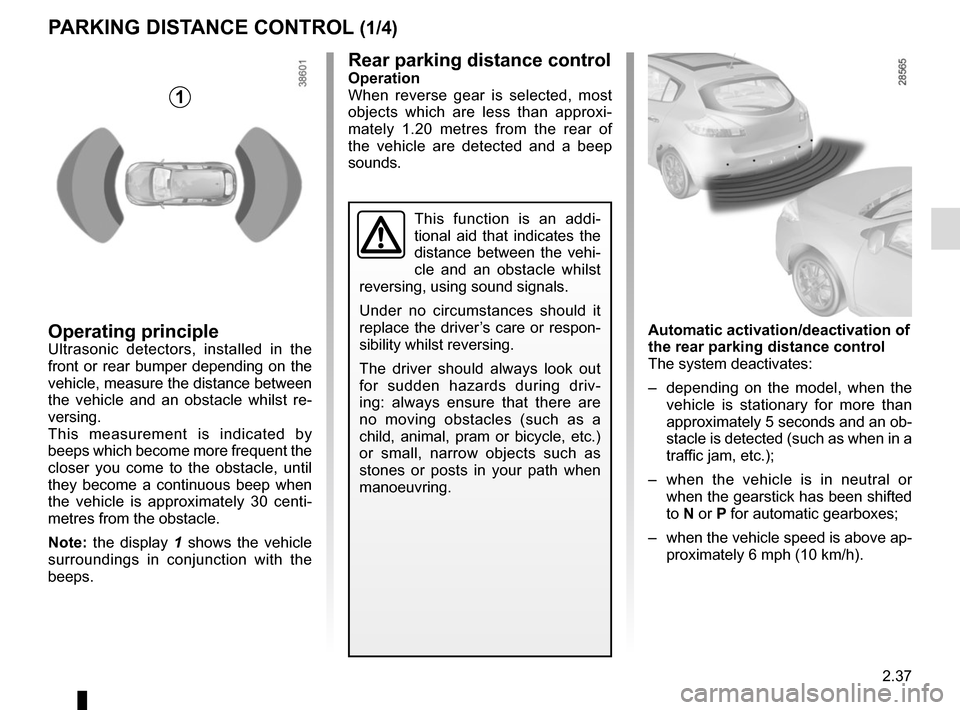
2.37
Rear parking distance controlOperation
When reverse gear is selected, most
objects which are less than approxi-
mately 1.20 metres from the rear of
the vehicle are detected and a beep
sounds.
Operating principleUltrasonic detectors, installed in the
front or rear bumper depending on the
vehicle, measure the distance between
the vehicle and an obstacle whilst re-
versing.
This measurement is indicated by
beeps which become more frequent the
closer you come to the obstacle, until
they become a continuous beep when
the vehicle is approximately 30 centi-
metres from the obstacle.
Note: the display 1 shows the vehicle
surroundings in conjunction with the
beeps.
PARKING DISTANCE CONTROL (1/4)
Automatic activation/deactivation of
the rear parking distance control
The system deactivates:
– depending on the model, when the vehicle is stationary for more than
approximately 5 seconds and an ob-
stacle is detected (such as when in a
traffic jam, etc.);
– when the vehicle is in neutral or when the gearstick has been shifted
to N or P for automatic gearboxes;
– when the vehicle speed is above ap- proximately 6 mph (10 km/h).
1
This function is an addi-
tional aid that indicates the
distance between the vehi-
cle and an obstacle whilst
reversing, using sound signals.
Under no circumstances should it
replace the driver’s care or respon-
sibility whilst reversing.
The driver should always look out
for sudden hazards during driv-
ing: always ensure that there are
no moving obstacles (such as a
child, animal, pram or bicycle, etc.)
or small, narrow objects such as
stones or posts in your path when
manoeuvring.
Page 132 of 268
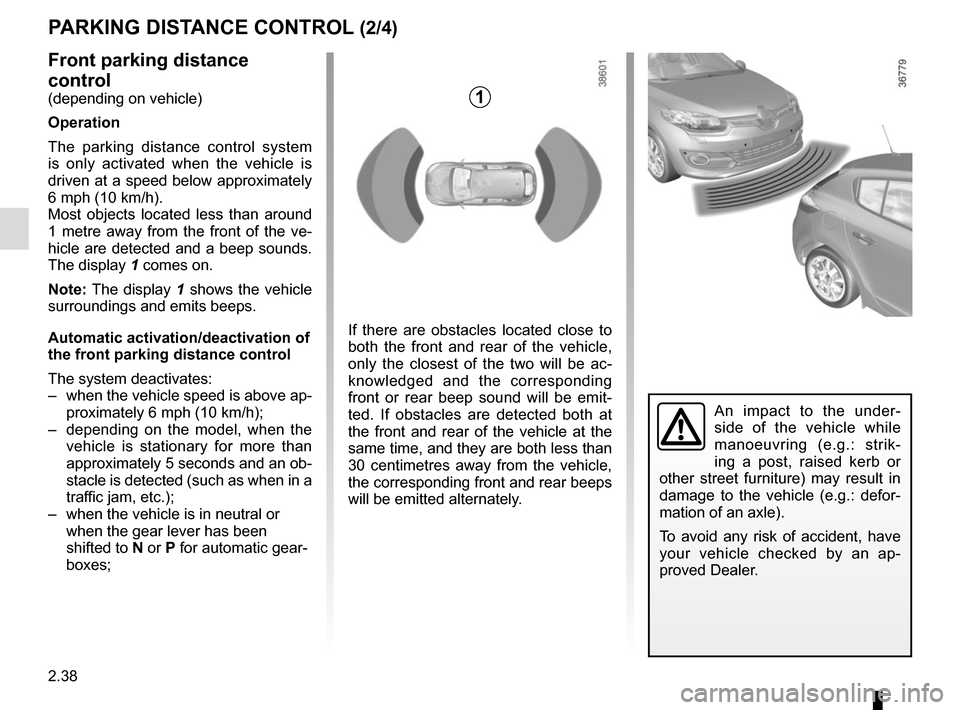
2.38
PARKING DISTANCE CONTROL (2/4)
An impact to the under-
side of the vehicle while
manoeuvring (e.g.: strik-
ing a post, raised kerb or
other street furniture) may result in
damage to the vehicle (e.g.: defor-
mation of an axle).
To avoid any risk of accident, have
your vehicle checked by an ap-
proved Dealer.
Front parking distance
control
(depending on vehicle)
Operation
The parking distance control system
is only activated when the vehicle is
driven at a speed below approximately
6 mph (10 km/h).
Most objects located less than around
1 metre away from the front of the ve-
hicle are detected and a beep sounds.
The display 1 comes on.
Note: The display 1 shows the vehicle
surroundings and emits beeps.
Automatic activation/deactivation of
the front parking distance control
The system deactivates:
– when the vehicle speed is above ap- proximately 6 mph (10 km/h);
– depending on the model, when the vehicle is stationary for more than
approximately 5 seconds and an ob-
stacle is detected (such as when in a
traffic jam, etc.);
– when the vehicle is in neutral or when the gear lever has been
shifted to N or P for automatic gear-
boxes; If there are obstacles located close to
both the front and rear of the vehicle,
only the closest of the two will be ac-
knowledged and the corresponding
front or rear beep sound will be emit-
ted. If obstacles are detected both at
the front and rear of the vehicle at the
same time, and they are both less than
30 centimetres away from the vehicle,
the corresponding front and rear beeps
will be emitted alternately.1
Page 133 of 268
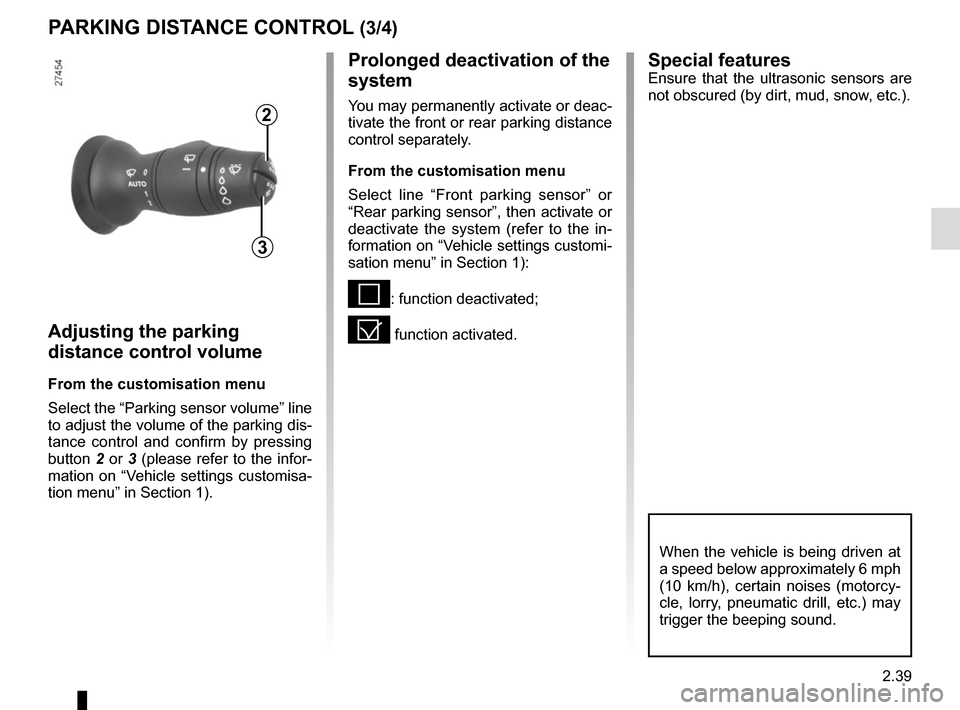
2.39
PARKING DISTANCE CONTROL (3/4)Special features
Ensure that the ultrasonic sensors are
not obscured (by dirt, mud, snow, etc.).Prolonged deactivation of the
system
You may permanently activate or deac-
tivate the front or rear parking distance
control separately.
From the customisation menu
Select line “Front parking sensor” or
“Rear parking sensor”, then activate or
deactivate the system (refer to the in-
formation on “Vehicle settings customi-
sation menu” in Section 1):
<: function deactivated;
= function activated.Adjusting the parking
distance control volume
From the customisation menu
Select the “Parking sensor volume” line
to adjust the volume of the parking dis-
tance control and confirm by pressing
button 2 or 3 (please refer to the infor-
mation on “Vehicle settings customisa-
tion menu” in Section 1).
2
3
When the vehicle is being driven at
a speed below approximately 6 mph
(10 km/h), certain noises (motorcy-
cle, lorry, pneumatic drill, etc.) may
trigger the beeping sound.
Page 134 of 268
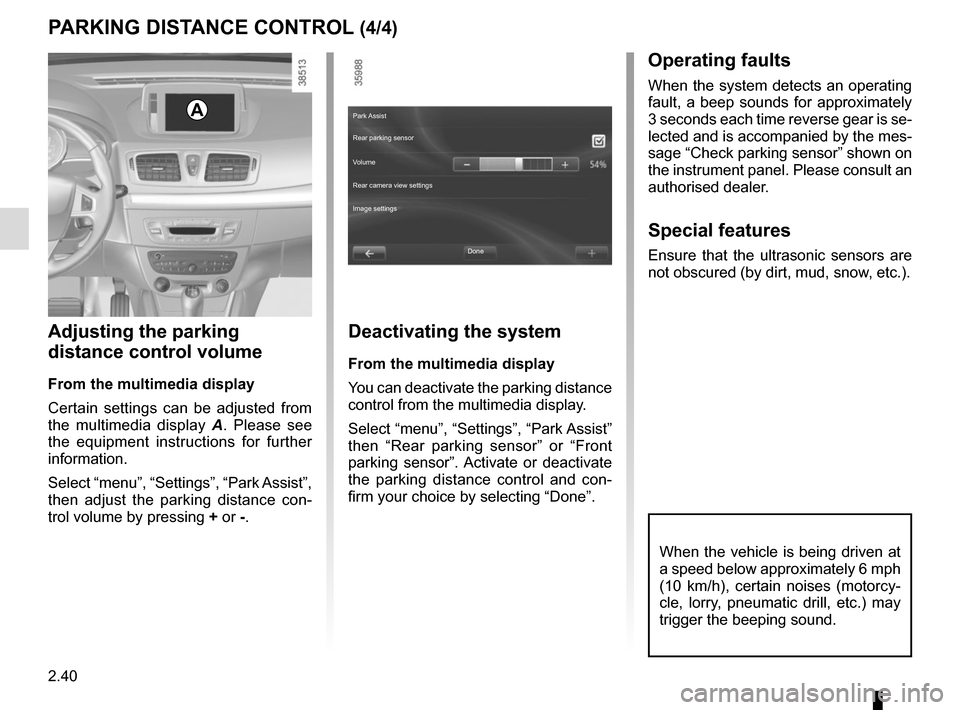
2.40
When the vehicle is being driven at
a speed below approximately 6 mph
(10 km/h), certain noises (motorcy-
cle, lorry, pneumatic drill, etc.) may
trigger the beeping sound.
PARKING DISTANCE CONTROL (4/4)
Adjusting the parking
distance control volume
From the multimedia display
Certain settings can be adjusted from
the multimedia display A. Please see
the equipment instructions for further
information.
Select “menu”, “Settings”, “Park Assist”,
then adjust the parking distance con-
trol volume by pressing + or -.
Deactivating the system
From the multimedia display
You can deactivate the parking distance
control from the multimedia display.
Select “menu”, “Settings”, “Park Assist”
then “Rear parking sensor” or “Front
parking sensor”. Activate or deactivate
the parking distance control and con-
firm your choice by selecting “Done”.
Done
Park Assist
Rear parking sensor
Volume
Image settings Rear camera view settings
Operating faults
When the system detects an operating
fault, a beep sounds for approximately
3 seconds each time reverse gear is se-
lected and is accompanied by the mes-
sage “Check parking sensor” shown on
the instrument panel. Please consult an
authorised dealer.
Special features
Ensure that the ultrasonic sensors are
not obscured (by dirt, mud, snow, etc.).
A
Page 135 of 268
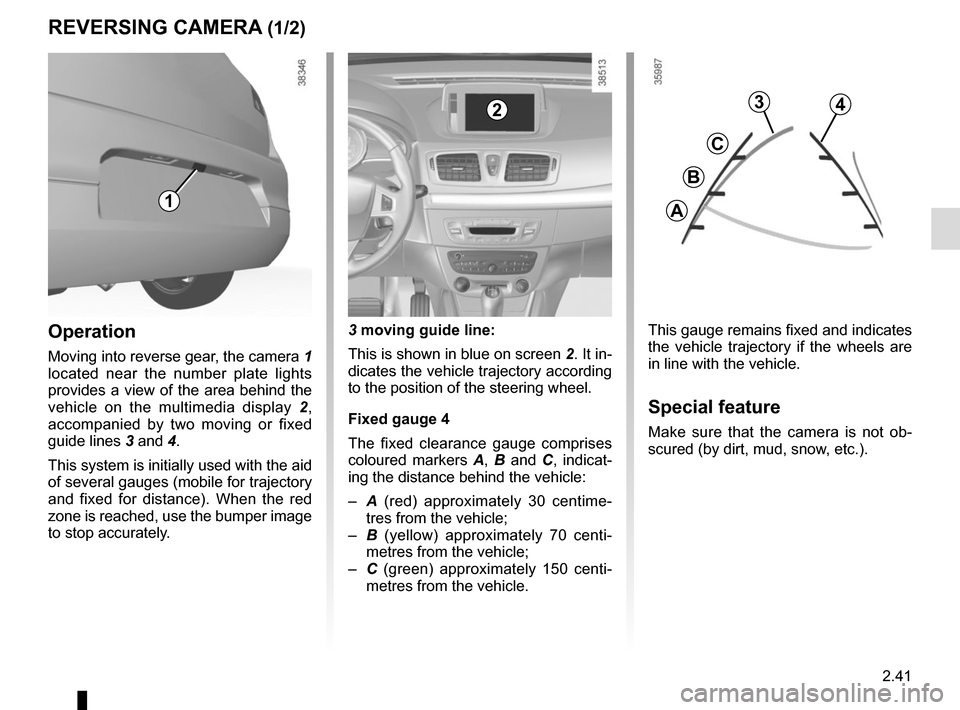
2.41
REVERSING CAMERA (1/2)
1
3
C
B
A
4
This gauge remains fixed and indicates
the vehicle trajectory if the wheels are
in line with the vehicle.
Special feature
Make sure that the camera is not ob-
scured (by dirt, mud, snow, etc.).
3 moving guide line:
This is shown in blue on screen
2. It in-
dicates the vehicle trajectory according
to the position of the steering wheel.
Fixed gauge 4
The fixed clearance gauge comprises
coloured markers A, B and C , indicat-
ing the distance behind the vehicle:
– A (red) approximately 30 centime-
tres from the vehicle;
– B (yellow) approximately 70 centi-
metres from the vehicle;
– C (green) approximately 150 centi-
metres from the vehicle.
Operation
Moving into reverse gear, the camera 1
located near the number plate lights
provides a view of the area behind the
vehicle on the multimedia display 2,
accompanied by two moving or fixed
guide lines 3 and 4.
This system is initially used with the aid
of several gauges (mobile for trajectory
and fixed for distance). When the red
zone is reached, use the bumper image
to stop accurately.
2
Page 136 of 268
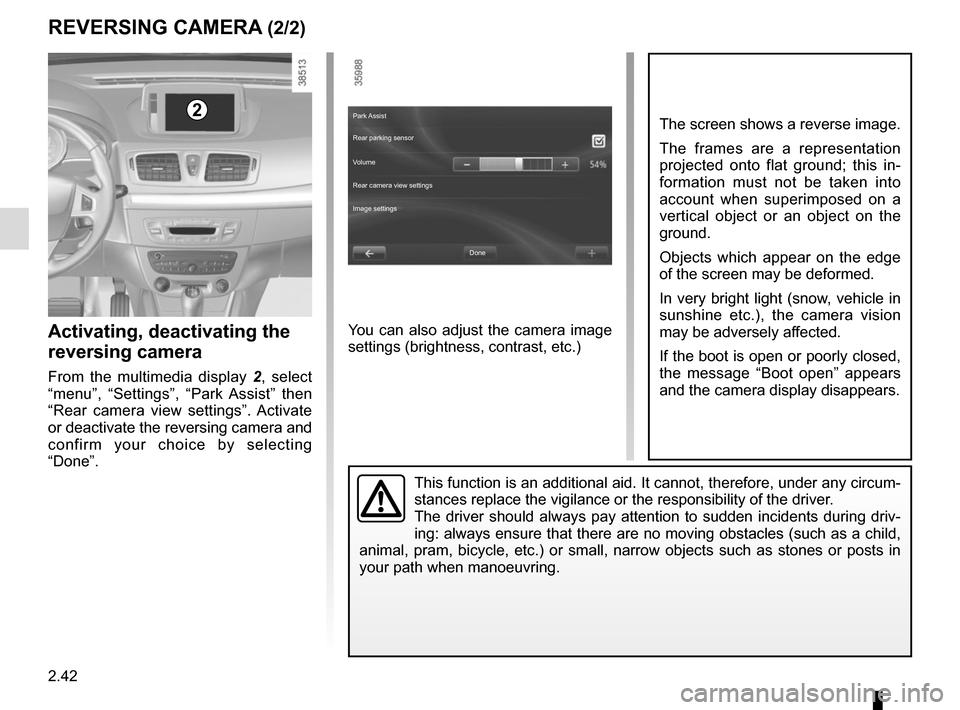
2.42
REVERSING CAMERA (2/2)
Park Assist
Rear parking sensor
Volume
Image settings Rear camera view settings
You can also adjust the camera image
settings (brightness, contrast, etc.)
The screen shows a reverse image.
The frames are a representation
projected onto flat ground; this in-
formation must not be taken into
account when superimposed on a
vertical object or an object on the
ground.
Objects which appear on the edge
of the screen may be deformed.
In very bright light (snow, vehicle in
sunshine etc.), the camera vision
may be adversely affected.
If the boot is open or poorly closed,
the message “Boot open” appears
and the camera display disappears.
This function is an additional aid. It cannot, therefore, under any circ\
um-
stances replace the vigilance or the responsibility of the driver.
The driver should always pay attention to sudden incidents during driv-
ing: always ensure that there are no moving obstacles (such as a child,\
animal, pram, bicycle, etc.) or small, narrow objects such as stones or\
posts in
your path when manoeuvring.
Activating, deactivating the
reversing camera
From the multimedia display 2 , select
“menu”, “Settings”, “Park Assist” then
“Rear camera view settings”. Activate
or deactivate the reversing camera and
confirm your choice by selecting
“Done”.
2
Done
Page 137 of 268
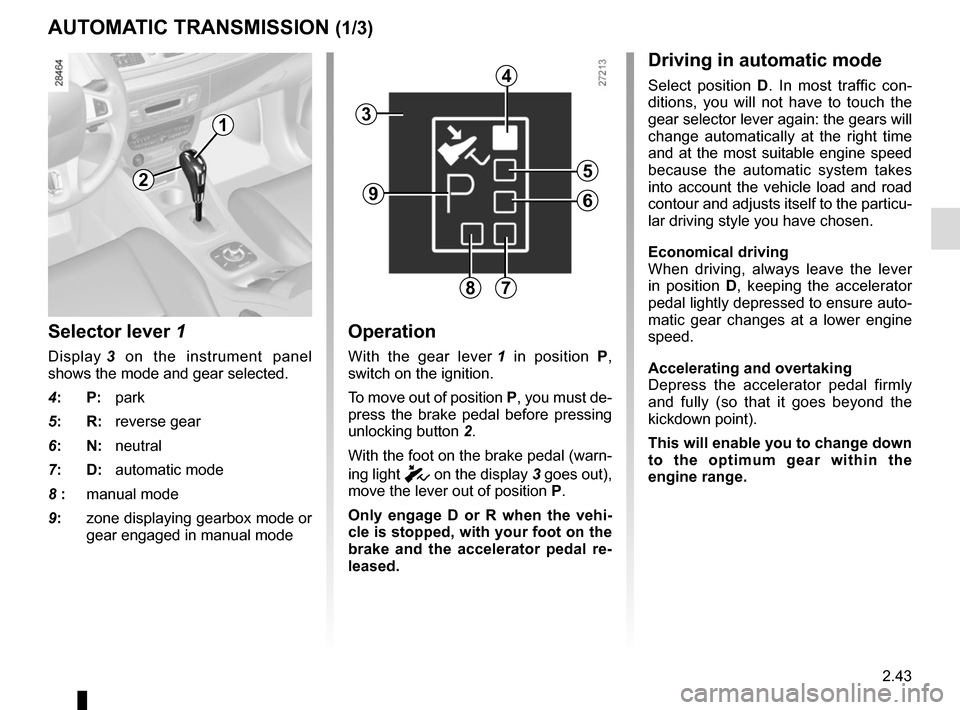
2.43
Selector lever 1
Display 3 on the instrument panel
shows the mode and gear selected.
4: P: park
5: R: reverse gear
6: N: neutral
7: D: automatic mode
8 : manual mode
9: zone displaying gearbox mode or
gear engaged in manual mode
Operation
With the gear lever 1 in position P,
switch on the ignition.
To move out of position P, you must de-
press the brake pedal before pressing
unlocking button 2.
With the foot on the brake pedal (warn-
ing light
c on the display 3 goes out),
move the lever out of position P.
Only engage D or R when the vehi-
cle is stopped, with your foot on the
brake and the accelerator pedal re-
leased.
AUTOMATIC TRANSMISSION (1/3)
Driving in automatic mode
Select position D. In most traffic con-
ditions, you will not have to touch the
gear selector lever again: the gears will
change automatically at the right time
and at the most suitable engine speed
because the automatic system takes
into account the vehicle load and road
contour and adjusts itself to the particu-
lar driving style you have chosen.
Economical driving
When driving, always leave the lever
in position D, keeping the accelerator
pedal lightly depressed to ensure auto-
matic gear changes at a lower engine
speed.
Accelerating and overtaking
Depress the accelerator pedal firmly
and fully (so that it goes beyond the
kickdown point).
This will enable you to change down
to the optimum gear within the
engine range.
3
2
1
4
5
6
78
9
Page 138 of 268
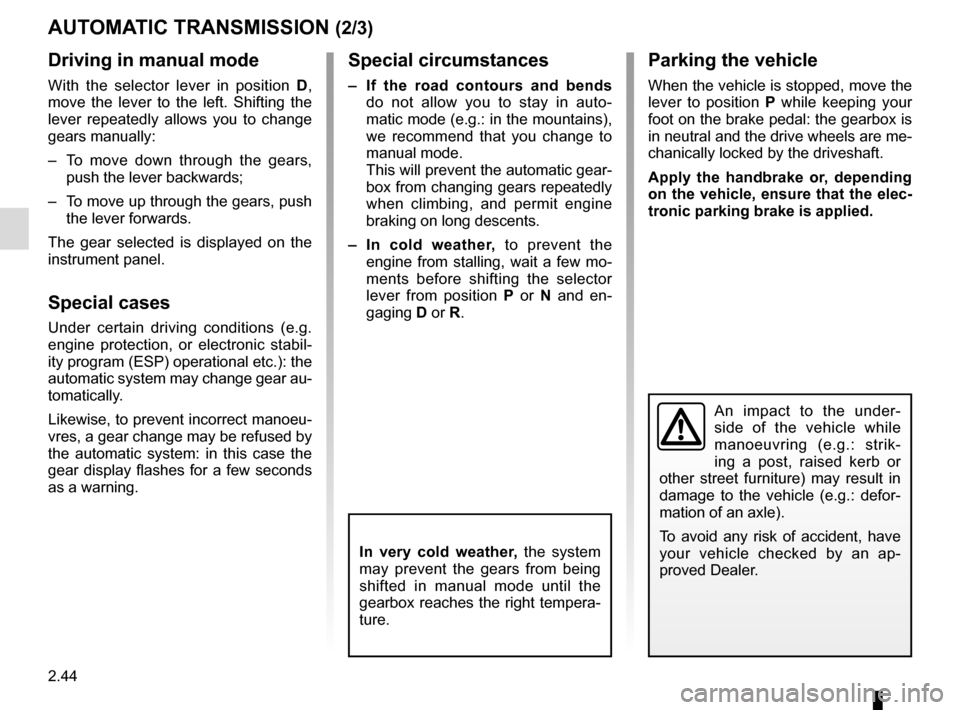
2.44
Parking the vehicle
When the vehicle is stopped, move the
lever to position P while keeping your
foot on the brake pedal: the gearbox is
in neutral and the drive wheels are me-
chanically locked by the driveshaft.
Apply the handbrake or, depending
on the vehicle, ensure that the elec-
tronic parking brake is applied.
Special circumstances
– If the road contours and bends
do not allow you to stay in auto-
matic mode (e.g.: in the mountains),
we recommend that you change to
manual mode.
This will prevent the automatic gear-
box from changing gears repeatedly
when climbing, and permit engine
braking on long descents.
– In cold weather, to prevent the
engine from stalling, wait a few mo-
ments before shifting the selector
lever from position P or N and en-
gaging D or R.
Driving in manual mode
With the selector lever in position D,
move the lever to the left. Shifting the
lever repeatedly allows you to change
gears manually:
– To move down through the gears, push the lever backwards;
– To move up through the gears, push the lever forwards.
The gear selected is displayed on the
instrument panel.
Special cases
Under certain driving conditions (e.g.
engine protection, or electronic stabil-
ity program (ESP) operational etc.): the
automatic system may change gear au-
tomatically.
Likewise, to prevent incorrect manoeu-
vres, a gear change may be refused by
the automatic system: in this case the
gear display flashes for a few seconds
as a warning.
AUTOMATIC TRANSMISSION (2/3)
In very cold weather, the system
may prevent the gears from being
shifted in manual mode until the
gearbox reaches the right tempera-
ture.
An impact to the under-
side of the vehicle while
manoeuvring (e.g.: strik-
ing a post, raised kerb or
other street furniture) may result in
damage to the vehicle (e.g.: defor-
mation of an axle).
To avoid any risk of accident, have
your vehicle checked by an ap-
proved Dealer.
Page 139 of 268
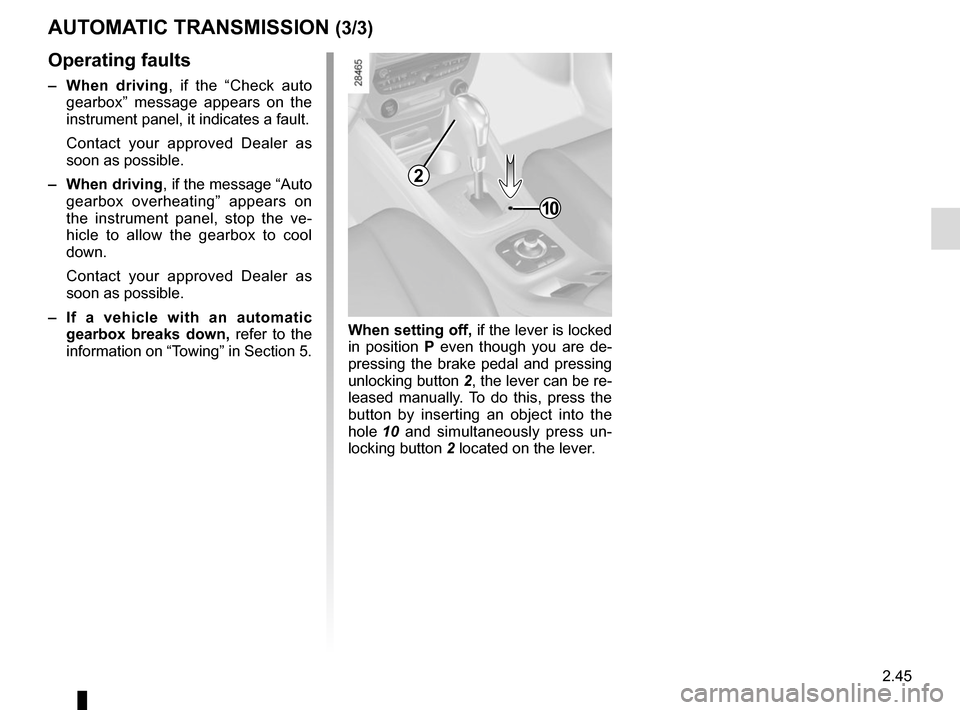
2.45
When setting off, if the lever is locked
in position P even though you are de-
pressing the brake pedal and pressing
unlocking button 2, the lever can be re-
leased manually. To do this, press the
button by inserting an object into the
hole 10 and simultaneously press un-
locking button 2 located on the lever.
AUTOMATIC TRANSMISSION (3/3)
Operating faults
– When driving , if the “Check auto
gearbox” message appears on the
instrument panel, it indicates a fault.
Contact your approved Dealer as
soon as possible.
– When driving , if the message “Auto
gearbox overheating” appears on
the instrument panel, stop the ve-
hicle to allow the gearbox to cool
down.
Contact your approved Dealer as
soon as possible.
– If a vehicle with an automatic
gearbox breaks down, refer to the
information on “Towing” in Section 5.
10
2
Page 140 of 268

2.46